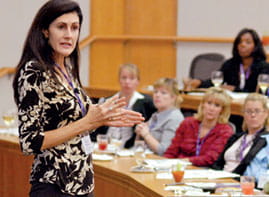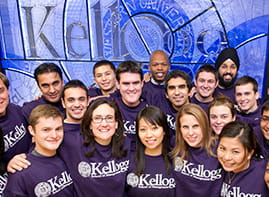'Poets' make 'leaps with assumptions' — and land in winner’s circle
In the final stage of the Kellogg Strategy Challenge, nine teams vied to offer the best solution to retailer Steve & Barry’s woes. But only one emerged victorious.
By Rachel Farrell1/9/2009 - In the 1990s, Steve & Barry’s was a thriving, lucrative business in the college apparel segment. By 2008, the company was out of business.
What happened to Steve & Barry’s? And can the firm be salvaged today?
Nine teams of first-year Kellogg students competed to offer the best answers to those questions Jan. 7 at the Kellogg Strategy Challenge, a contest that was launched to help students learn how to apply classroom lessons to real-world situations. The morning-long competition was built into the Kellogg School’s Management and Strategy course for the first time this year, and is expected to become an annual event.
Dressed in their most professional attire, the students presented their strategic proposals for Steve & Barry’s before nearly 100 Kellogg faculty, staff and students at the James L. Allen Center. The 40 student team members had been narrowed from a pool of 600 who vied in the preliminary competition in December. On Jan. 7, the finalists’ presentations were judged by a panel of thought leaders from Kellogg and the Chicago business community.
Steve & Barry’s thrived in part due to its central location on college campuses throughout the United States. But after changing its sales strategy and transitioning into the casual apparel business, the company underwent a rapid demise.
The teams first evaluated the reasons for the company’s downfall, citing factors such as store location, competition, customer segments, and pricing and production costs. They then proposed a strategy for reviving the company.
First place was awarded to the “Poets” team: Jason Stulberg, Jonathon Wong, Swapna Chandamuri and Yuki Oi. The team outlined its turnover plan for Steve & Barry’s, proposing that the firm be restructured and returned to its roots in the college apparel segment. They recommended a four-pronged plan that incorporated an exit from the casual apparel industry, higher prices, expansion into college campuses and the development of a mixed-management model.
“Each of us took a different piece [of the case] that we thought might be important — competitors, location, market dynamics,” Chandamuri said. “And then we got back together and discussed the key points and what the options might be.”
Team members also said they based their proposal on lessons learned in the Management and Strategy course. “We leveraged a lot of frameworks from the class,” Wong said. “We tried to build upon [those frameworks] that were most applicable to this business model.”
What differentiated the winning team was its ability “to make some leaps with assumptions and analytics,” explained judging panel member John Livingston, director and managing partner, McKinsey & Company. “Even if they didn’t have all the facts [from the case study], they found other facts and synthesized them into a conclusion that was both fact-based and practical.”
Second place was awarded to the “Bull Frogs” team — Michael Vondriska, Stephanie Choi, Ari Levin and Guneet Bedi — while third place was presented to the “Big Dogs” — Alexi Solit, Mariana Maraccini, Lifang Zhu, Daniel Thomas and Sarah Buhayer.
At the conclusion of the event, the judges shared their best practices for approaching cases, whether in an academic or professional setting.
“You have to remember what’s realistic,” said judging panel member Julie Coffman, a partner in the Chicago office of Bain & Company. “At the end of the day, it’s easy to draw a bunch of charts and have strategy, but you only have so much money and capabilities and time. So think through what a management team in this environment and economy can realistically do.”
Added Livingston, “Sometimes we settle for a great diagnosis and a typically straightforward plan of action. But that’s not the brass ring; it’s not the distinctive answer. As you go forward, ask yourself, ‘What’s the surprising answer?’”
Other members of the judging panel included Cesare Mainardi, managing director, Booz & Company, North America; Lawrence Shulman, senior partner and managing director, Boston Consulting Group, Chicago office; and David Besanko, Alvin J. Huss Professor of Management and Strategy and senior associate dean, planning and external relations.






